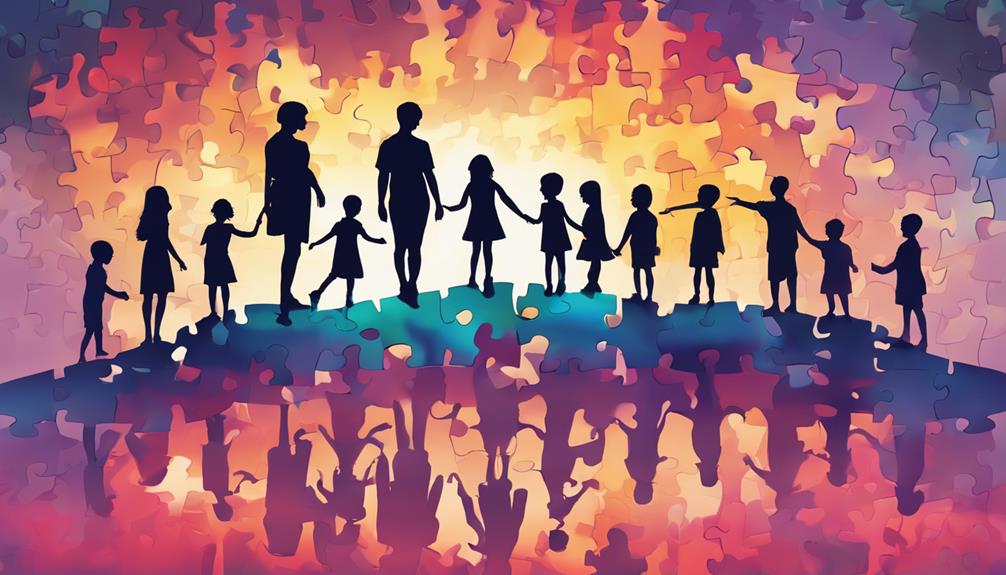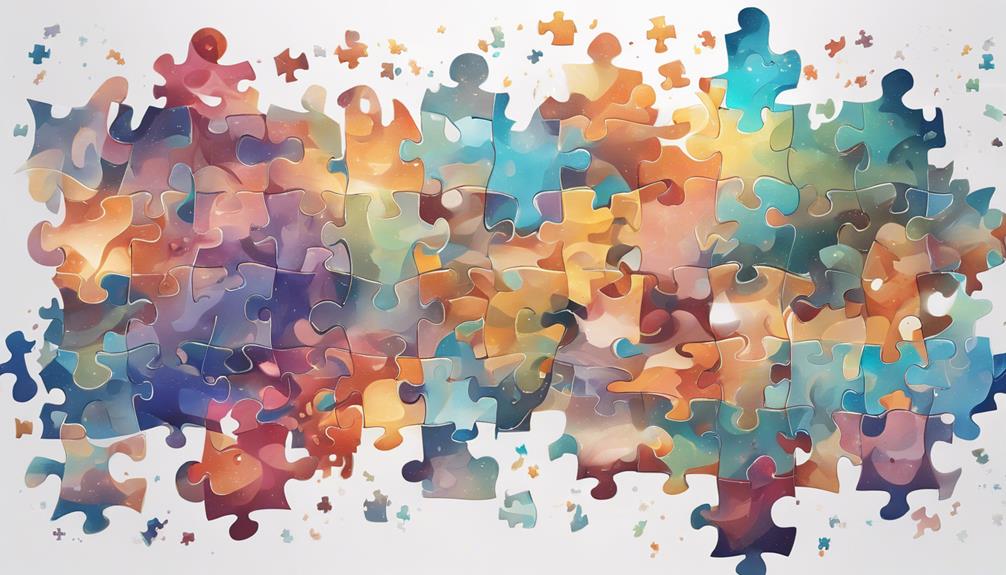Summary
- 1 Definition of the autism spectrum
- 2 Diagnostic criteria
- 3 Levels of support
- 4 Communication styles
- 5 Sensory processing
- 6 Social interaction
- 7 Behavioral patterns
- 8 Cognitive skills
- 9 Common misunderstandings
- 10 Frequently asked questions
- 10.1 What are some effective strategies to support individuals with autism in the workplace?
- 10.2 How can family members support a newly diagnosed individual with autism?
- 10.3 Are there specific dietary recommendations for people on the autism spectrum?
- 10.4 What is the role of technology in the lives of individuals with autism?
- 10.5 How can schools create inclusive environments for students on the autism spectrum?
It is necessary to understand that autism is a specific condition with significant challenges in the social communication and in the repetitive behaviors. However, the autistic spectrum is not a universal diagnosis; it encompasses a wide range of developmental conditions that vary greatly from person to person. People on the spectrum may have different communication styles, sensory sensitivities, and cognitive abilities. They may need different levels of support, from minimal help to extensive care. Interested in learning more? There is much more to discover about the unique aspects of each individual on the spectrum.
Definition of the autism spectrum

When you hear the term 'autistic spectrum', reference is made to a range of conditions of development that affect how a person communicates and interacts with others. Think of it as a broad spectrum with varying degrees of traits and challenges. Some people may have mild difficulties, while others may face more significant obstacles in the social and communicative interactions.
The autism spectrum is not a one condition for all. In contrast, it encompasses a variety of behaviors and skills. You might know someone who is very verbal but struggles with social cues, while another person might be nonverbal and find comfort in routines. Both individuals fall on the autism spectrum but experience it in unique ways.
Understanding the autism spectrum helps you understand that it is not about limitations but about differences. People on the spectrum often have incredible strengths, as attention to detail or exceptional memory. Recognizing these strengths is just as important as being aware of the challenges.
Diagnostic criteria
When diagnosing autism and its spectrum, it is essential to understand the MAIN FEATURES. It is also important to know the assessment tools that professionals use. Let's delve into these to understand how they help identify where a person is on the spectrum.
Key diagnostic features
Understanding the basic diagnostic features of autism is essential to identify and support individuals on the autism spectrum. Autism spectrum disorder (ASD) is primarily characterized by challenges in social communication and restrictive and repetitive behaviors. These key features help professionals distinguish autism from other developmental disorders.
First, let us divide the main areas into three categories:
| Category | Description | Examples |
|---|---|---|
| Social Communication | Difficulties in social interactions and understanding | Problems maintaining conversations, lack of eye contact |
| Repetitive Behaviors | Involvement in repetitive actions or routines | Waving hands, strict adherence to routines |
| Sensory Sensitivities | Unusual responses to sensory experiences | Overreaction to sounds, textures or lights |
In assessing social communication, you will notice that individuals with autism may find it difficult to interpret social cues or maintain reciprocal conversations. Repetitive behaviors may include repetitive speech and activities, and a strong preference for monotony. Sensory sensitivities mean that they may be hypersensitive or indifferent to sensory input such as sounds or textures.
Assessment tools used
There are several reliable assessment tools used to diagnose autism, each designed to capture the unique characteristics of the spectrum. One of the most commonly used tools is the Autism Diagnostic Observation Schedule (ADOS). This involves a series of structured and semi-structured tasks that allow professionals to observe social and communication behaviors.
Another key tool is the Autism Diagnostic Interview-Revised (ADI-R), which is a detailed interview conducted with parents or caregivers. This helps gather detailed information about the individual's developmental history and current behavior.
You may also hear about the Childhood Autism Rating Scale (CARS). This assessment is based on direct observation and is particularly useful in distinguishing autism from other developmental disorders. It assesses the child on a scale in various areas such as social interaction, communication, and sensory responses.
In addition, the Social Communication Questionnaire (SCQ) is a quick questionnaire completed by parents that screens for autism traits and helps determine if further evaluation is needed.
Each of these tools provides a piece of the puzzle, working together to form a complete picture. They are designed to make sure that no important detail is overlooked, making the diagnosis as accurate and useful as possible.
Levels of support

In relation to autism, you will notice that the support needs can vary greatly from person to person. Some may need minimal help, while others require more intensive assistance. Understanding these differences is critical to creating intervention strategies customized to actually work.
Variable support requirements
Support requirements for people on the autism spectrum can vary widely, from those who need minimal assistance to those who require substantial and ongoing care. You may find that some people on the spectrum are highly independent, able to handle daily tasks and social interactions with little or no help. They may need only occasional guidance or support in specific situations.
On the other hand, there are individuals who require a moderate level of support. These people may have difficulty with certain social cues, organizational skills, or sensory sensitivities. They might benefit from regular supervision, structured environments, and tools to help them stay organized and focused.
Then, there are those who require substantial and ongoing care. These people may have significant challenges in communication, self-care, and daily living skills. They often need full-time assistance from caregivers to navigate their world safely and comfortably.
Understanding these different support requirements is essential. It helps you understand the diversity within the autism spectrum and recognize that each person's needs are unique. This knowledge is the basis for providing the right level of care and support, ensuring that each individual can thrive in his or her own way.
Customized intervention strategies
Creating individualized intervention strategies is essential to meet the unique support needs of people on the autism spectrum. By adapting approaches, each person's specific challenges and strengths can be addressed. Not all people with autism will need the same level of support, so it is important to identify and adapt to their individual needs. Here is a brief guide to help you understand how to create personalized and effective strategies:
- Assessing Individual Needs: Begin by understanding the person's strengths and areas where he or she needs support. This could involve dialogue with caregivers, teachers or directly with individuals.
- Establishing Clear Goals: Define what you want to achieve with the intervention. Goals can range from improving communication skills to increasing social interactions.
- Choosing Appropriate Interventions: Select strategies that are evidence-based and appropriate to the person's level of functioning. Options might include speech therapy, occupational therapy or social skills training.
- Monitor and Adapt: Review the effectiveness of interventions regularly. Be ready to make adjustments based on progress or changes in needs.
Communication styles
Communication styles can vary greatly among individuals in the autism spectrum, often presenting distinct challenges and strengths. You may notice that some people on the spectrum are very direct in communication, saying exactly what they mean without any hidden meaning. This can be stimulating, but can sometimes seem abrupt. Others may have difficulty with the verbal communication and prefer to express themselves through writing, art or other non-verbal means.
You will also find that some individuals have a rich vocabulary and can talk at length about topics they are passionate about. However, they may find it difficult to entertain superficial chatter or understand social signals, such as body language and facial expressions. It is not uncommon for them to take things literally, which can lead to misunderstandings in everyday conversations.
On the other hand, their unique way of communicating often leads to a unique perspective And can be incredibly profound. They can notice details that others overlook and bring a level of honesty that is rare. Understanding these communication styles can help you interact more effectively and build stronger, more meaningful relationships with people on the autism spectrum.
Sensory processing

When it comes to sensory processing, individuals on the autism spectrum often experience the world in ways that can be both overwhelming and fascinating. Sensory information, such as sounds, noises, smells, and textures, can be processed differently, sometimes more intensely or less intensely than neurotypical individuals. This can lead to unique challenges and experiences in daily life.
Here are some ways in which sensory processing may differ:
- Hypersensitivity: Some may find everyday noises, such as the hum of a refrigerator, unbearably loud or distracting.
- Hyposensitivity: Others may not notice pain or temperature changes, needing stronger stimuli to perceive the sensations.
- Sensory research: Engaging in activities that provide strong sensory input, such as turning on oneself or touching various textures, can be relaxing or stimulating.
- Sensory avoidance: Avoiding certain sensations, such as specific fabrics or bright lights, helps manage overwhelming input.
Understanding these differences is essential to creating supportive environments. For example, providing noise-canceling headphones or allowing breaks in a quiet space can make a difference. The next time you meet someone on the autism spectrum, keep in mind that their sensory world may be significantly different from yours, but with some adaptations, you can help make their experience more comfortable.
Understand thesocial interaction on the autism spectrum means recognizing the unique ways in which individuals might express themselves or interpret social signals. People with autism may find social interactions challenging. They may have difficulty reading the facial expressions, of the tone of voice or of the body language, which makes it complicated to understand others' emotions. Sometimes they may not know how to start or maintain a conversation, making the socilize an overwhelming experience.
It is also important to note that individuals on the autism spectrum can have varying levels of social skills. Some may be very talkative but may not follow social norms, such as taking turns in conversation. Others may prefer limited interactions or feel more comfortable communicating in nontraditional ways, such as through writing or the use of technology.
Being patient and empathetic is critical. When interacting with someone on the autism spectrum, allowing them time to process and respond can make a big difference. They may need communication direct and clear without relying on subtle suggestions or sarcasm. By understanding and adapting to these needs, it is possible to create a more inclusive environment that respects and values their unique perspectives.
Behavioral patterns

You will notice that behavioral patterns in people on the autism spectrum can be very diverse, often marked by repetitive actions or a strong preference for routine. These behaviors might seem unusual at first, but they play a significant role in providing comfort and predictability.
Some common behavioral patterns you might observe include:
- Repetitive Actions: This may include such things as flapping hands, rocking or repeating certain activities over and over again.
- Structured Routines: People often prefer to do things in the same order or way every day. Changes can be distressing and may lead to anxiety.
- Intense Interests: They may have very strong interests in specific topics, sometimes to the exclusion of other activities.
- Sensory Sensitivities: Sensitivity to light, sounds, textures or smells can lead to avoidance of certain environments or experiences.
Understanding these patterns can help you create a supportive environment. For example, maintaining a consistent schedule or providing a quiet space can make a significant difference. It is also helpful to be patient and adaptable, as these behaviors are part of how they navigate the world. By recognizing and honoring these patterns, you can foster a more inclusive and empathetic atmosphere.
Cognitive skills
Cognitive abilities in people on the autism spectrum can vary widely, often showing unique strengths along with distinct challenges. You may notice that some people with autism have exceptional abilities in areas such as math, music, or art. These abilities are sometimes referred to as 'islets of skill'. It is fascinating how someone could solve complex puzzles in record time or create incredibly detailed drawings.
However, it is important to understand that the cognitive skills are not the same for everyone on the spectrum. Some may have difficulty with tasks involving social understanding, communication or flexible thinking. You may find that abstract concepts or multi-step instructions Are difficult for them to understand.
Common misunderstandings

Despite the various cognitive abilities present in individuals on the autism spectrum, there are several common misconceptions that can lead to misunderstanding and stigma. It is important to clarify these to foster a more inclusive and supportive environment.
- Autism is a disease: Autism is not a disease that needs to be cured. It is a neurodevelopmental condition that affects how people communicate and interact with the world.
- All autistic people are the same: The autism spectrum is broad, and no individual is exactly the same. Each person has his or her own strengths and challenges.
- Autistic people lack empathy: Many people believe that individuals with autism cannot understand or share feelings, but this is not true. They may express empathy differently, but it is often present.
- Individuals with autism cannot lead successful lives: Many people with autism lead fulfilling lives, have careers and maintain relationships. With the right support, they can achieve great things.
Frequently asked questions
What are some effective strategies to support individuals with autism in the workplace?
To support individuals with autism in the workplace, it is important to create a structured environment. La clear communication is crucial: use direct language and written instructions. Offer flexible working hours if necessary and provide a quiet space for breaks. Training colleagues on autism can foster a more inclusive atmosphere. Most importantly, ask the person directly what supports they find helpful. Their input is invaluable!
How can family members support a newly diagnosed individual with autism?
As a family member, you can support a newly diagnosed autistic individual by being patient and understanding. Find out their needs and preferences, and create a calm, structured environment. Encourage open communication and celebrate their strengths. Connect with support groups to gain perspectives from others' experiences. Remember, your acceptance and love are critical to helping them thrive and feel valued.
Are there specific dietary recommendations for people on the autism spectrum?
In terms of dietary recommendations for individuals on the autism spectrum, there is no universal solution. However, many find that a balanced diet rich in whole foods is beneficial. Some parents and caregivers investigate diets without gluten o casein, thinking that they can improve behavior and digestion. It is always advisable to consult a health professional before making significant dietary changes to confirm that you are meeting nutritional requirements.
What is the role of technology in the lives of individuals with autism?
Technology can play a huge role in an autistic person's life. It helps them communicate better, learn new skills, and even relax. Applications and devices can assist with verbal communication, social interactions and organization. In addition, video games and virtual reality offer fun ways to practice social scenarios. Don't forget that technology can also create a calm and predictable environment, reducing anxiety and making daily activities easier.
How can schools create inclusive environments for students on the autism spectrum?
To create inclusive environments in schools, you can start by training teachers on autism. Use visual material, clear instructions and structured routines To help students feel more comfortable. It encourages the peer support and promote a culture of kindness and acceptance. It is also essential to work with parents and specialists to tailor strategies to each child's needs. Small adjustments can make a big difference in making everyone feel included.
